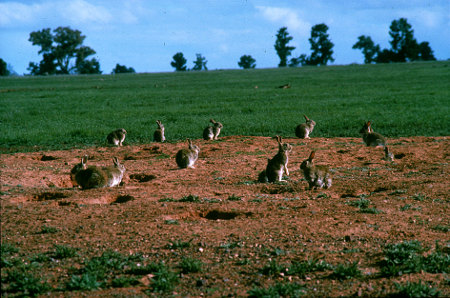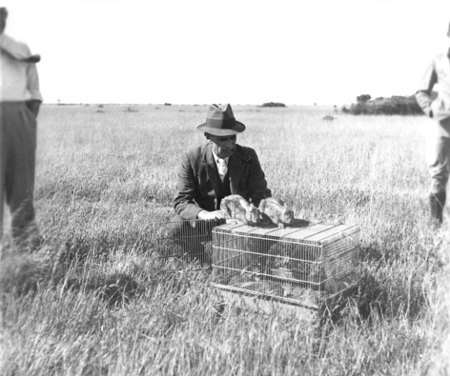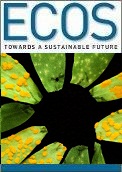
|
Published: 19 December 2011
Rabbits' resurgence puts the bush under pressure
Rabbits are back – in increasing numbers, posing a major threat to Australia’s recovering landscapes.
When the biocontrol rabbit haemorrhagic disease (RHD) was released in the mid 1990s, its impact on rabbit populations was dramatic, particularly in the arid zone. As rabbits disappeared from the landscape, so too did their predators – foxes and cats. Small native animals recolonised areas they had been hunted out of for decades, and native trees and shrubs began to regenerate.
Agriculture also benefited, by an estimated $400 million a year, through improved pasture production that flowed on: particularly into the wool and beef industries.
But while rabbits are still largely controlled in agricultural areas, thanks to a combination of biological control agents and traditional methods (such as poisoning, destroying warrens and fumigation), RHD’s effectiveness in natural areas has waned in the past few years. Rabbit populations are once again on the increase, and they are having a dramatic impact on Australia’s ecological assets.
This impact, including effects on some of the nation’s 156 threatened native plants and animals – nine of which are critically endangered – is a key driver for the next phase of rabbit research by the Invasive Animals CRC through to 2017 and beyond.
‘One of the biggest challenges we face is the lack of understanding about how few rabbits it takes to do a lot of damage to the bush,’ says Dr Brian Cooke, from the Invasive Animals CRC and Institute for Applied Ecology at the University of Canberra.
‘It takes less than a rabbit per hectare to take out many native seedlings, but at that level, most people don’t recognise that there is a rabbit problem.
‘No one – including scientists and conservation managers – notices the absence of seedlings; they see only old trees but don’t consider why that is – or that there might be a rabbit problem,’ he explains.
Mr Greg Mutze, Senior Research Officer at Biosecurity SA, agrees.
‘Rabbits have significantly altered the composition of vegetation communities,’ he says. ‘Just a couple of rabbits may prevent the growth of a plant species the conservation manager has never seen and doesn’t realise is missing.’
‘There is also a widespread misconception that the rabbit problem has been solved, stemming from the fact that, 70 years ago, rabbits were visibly a far worse problem than now,’ he observes.
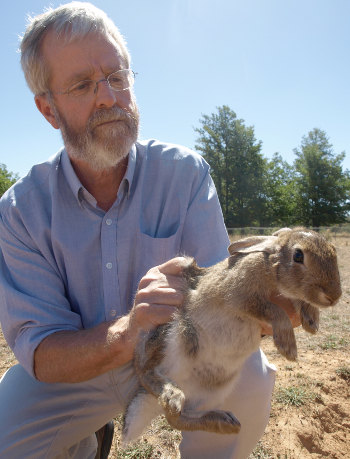
|
|
Dr Brian Cooke has spent his career researching and advising on the European rabbit’s impacts on Australia and the best ways to counteract them.
Credit: Invasive Animals CRC
|
Drier areas are vulnerable
Mr Peter Sandell, Environment Program Manager at Parks Victoria, says that the semi-arid zone – in particular, the Mallee – is very susceptible to rabbits because of the annual cycle of food availability.
‘Rabbits selectively browse the seedlings of trees, shrubs and other vegetation like ground orchids, and prevent their regeneration,’ says Mr Sandell.
‘Other areas may not be as vulnerable because biomass production outstrips consumption, but in the Mallee, few plants escape rabbit browsing.
‘Only overstorey trees – many of which are now more than 150 years old – have remained untouched during rabbit population peaks. There was no regrowth at all.’
He says, however, that ‘this changed in the years following the RHD outbreak, with regeneration of woody tree species.’
Threatened plants and native animals are affected
Where rabbits continue to be actively controlled, native vegetation is regenerating, and populations of native animals are returning. But where they have not been controlled, their impact continues to be felt. For example, birds such as Major Mitchell’s cockatoo and white-browed treecreeper are under pressure in the Mallee, because of habitat loss and a lack of suitable nesting sites. 1
‘Elsewhere, rabbit numbers have rebounded, but it is not uniform,’ says Mr Mutze. ‘At some sites, rabbit populations have held at very low numbers, but in many other areas, numbers have recovered substantially – especially in cool moist areas and on the coastal fringe.’
Research 2 in north-western Victoria’s Hattah-Kulkyne National Park revealed that a threatened native casuarina tree known as buloke (Allocasuarina luehmannii) regenerated successfully for the first time in 50 years after the spread of RHD. But, increasing rabbit abundance since 2004 has destroyed some of these seedlings.
Meanwhile, a study in Coorong National Park showed that even at a density of one animal per two hectares, rabbits can removed all sheoak seedlings (Allocasuarina verticillata) in that area.
‘Some native fauna, such as endangered glossy black cockatoos, feed almost exclusively on Allocasuarina, so it is critical that they are allowed to regenerate,’ says Mr Mutze.
‘Even at the lowest levels post-RHD, rabbits were still a major problem, and numbers are heading back up from that position,’ he comments. ‘If steps aren’t taken to control them through landscape-scale control measures, many small native reserves are doomed.’
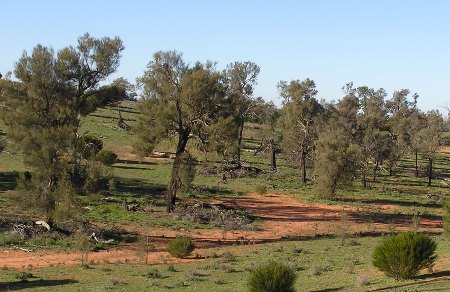
|
|
Buloke trees and seedlings regenerate for the first time in 50 years in Hattah-Kulkyne National Park, north-west Victoria, thanks to reduced rabbit numbers.
Credit: Fiona Murdoch
|
Winning the arms race
While the economic benefits to agriculture have been easier to measure, placing a value on the damage done by rabbits to natural areas has been much harder.
‘When we looked at the cost of controlling rabbits in roadside native vegetation in South Australia’s Mallee region, we found that it would cost at least $2100 per hectare to replant species,’ says Dr Cooke. ‘This excludes the cost of weeding and pest control while the replanted vegetation becomes established.’
By comparison, he says that control measures cost substantially less than replanting: baiting with 1080 poison is $52/hectare, warren ripping is $40/hectare and fumigation is $58/hectare. 3
Despite some public distaste for these methods on animal welfare grounds, biological control agents on their own simply aren’t enough, according to Dr Cooke. They work well for 10–15 years, then rabbits develop genetic resistance.
‘We became complacent about rabbit control following the release of RHD, but we should have been preparing for the next phase,’ says Mr Sandell.
‘RHD is still effective to a degree, killing most infected rabbits and preventing the huge population peaks that we saw previously,’ he explains. ‘However, rabbits’ fecundity means we need a combination of highly effective biological agents and conventional control methods to stay at the front of the arms race.’
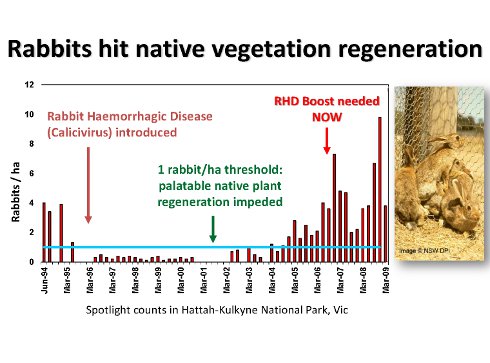
|
|
This graph of rabbit counts from 1994–2009 in Hattah-Kulkyne National Park, north-west Victoria, shows decline in rabbit numbers with RHD and the most recent surge since 2004. A larger version is available here.
Credit: Invasive Animals CRC
|
The Invasive Animals CRC RHD Boost project, being jointly undertaken by the NSW Department of Primary Industries (NSW DPI) and CSIRO, aims to identify and evaluate novel, more virulent overseas RHD virus strains that are able to better control rabbits in temperate areas. The rabbits in these areas have a stronger resistance to the disease. The project is well underway, and the Elizabeth Macarthur Agricultural Institute within NSW DPI has been screening the effectiveness of other strains of RHD.
In tandem, CSIRO has been working with French scientists on genetic variability among rabbits to determine what makes them more susceptible to certain strains.
To create a RHD resistance model, the Invasive Animals CRC has enlisted expertise from the Institute of Zoo and Wildlife Research in Germany. The Institute is working with the University of Canberra, state agencies and CSIRO to produce the strategic knowledge required to maintain RHD as an effective biocontrol agent in Australia.
Conservation groups can help
Dr Cooke believes that conservation groups have a significant role to play in the management of rabbits. Groups can participate in joint rabbit control programs, educate conservation managers of the potential damage that can be caused by just a few animals, and raise awareness among the public about rabbits’ potential impact.
‘Overall, the big problem is one of perception,’ says Dr Cooke. ‘As rabbits become less numerous, people worry less. But we need to maintain the rage and keep people aware of the issue – and that rabbits infest 70 per cent of Australia.’
‘There is a growing idea that rabbits are nice and shouldn’t be harmed, but making decisions along these lines assumes that rabbits are far more important than sheoaks or the native birds and animals they are displacing. Nobody who enjoys our natural bushland and landscapes would agree with that.’
1 Sandell P (2011). Victoria’s Rangelands: In Recovery or in Transition. Report from a Parks Victoria Sabbatical Project.
2 Murdoch F A (2007). Evaluating the effects on Buloke regeneration of increased browsing by rabbits - Hattah Kulkyne National Park. A report prepared for the Dept. of Sustainability and Environment and Parks Victoria. The PestSmart case study on rabbit control in the Hattah-Kulkyne National Park can also be downloaded here.
3 Cooke B (2011). Planning landscape-scale rabbit control, Invasive Animals Cooperative Research Centre.


